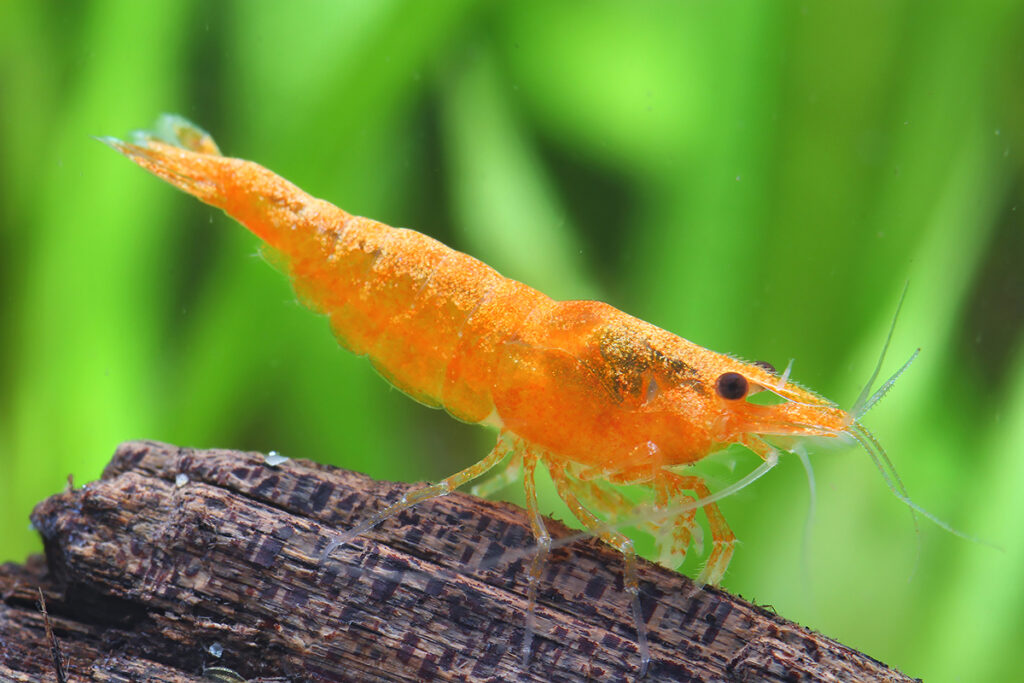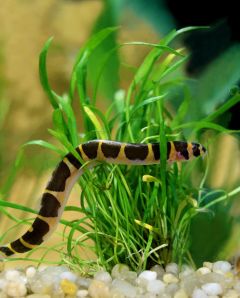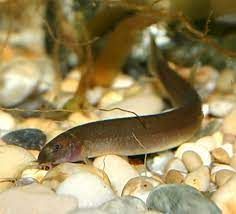Kuhli Loach Care Guide: Tank Mates, Tank Setup, Breeding, Diet & More

Table of Contents
Species overview
Kuhli Loaches (Pangio kuhlii) "Coolie loach" are a popular addition to freshwater tanks. Wild Kuhli loaches natural habitat is Southeast Asia, these slender eel-like fish are known for their bright orange and black stripes, as well as their curious behavior. Kuhli loach prefer warmer water temperatures between 74-80°F (24-27°C). They are a schooling species within the aquarium environment. They are ideal for community tank setups.
Appearance & Behavior
Kuhli Loaches are an eel shaped fish, with an elongated dorsal and ventral profile. They have a characteristic orange and black striped pattern along their body, which can range in intensity from faint to bold depending on the individual. Kuhli loach are typically considered smaller fish, with most reaching a maximum size of around 4 inches
Kuhli loach fish are active and curious creatures, often exploring their tank environment and investigating any objects they come across. They display a unique behavior known as ‘bobbing’, in which they rhythmically rise to the surface of the water and then sink back down again. This behavior is thought to be used as a means of communication between them. In general they will be found at the bottom of the tank
Food and diet info
Kuhli Loaches are omnivores and should be fed a balanced diet consisting of both meaty and vegetable based foods. Kuhli loaches eat live food such as freshly hatched brine shrimp, black worms, daphnia, bloodworms, and other small invertebrates. Freeze-dried or frozen food versions of these foods can also be offered like frozen bloodworms, as well as sinking pellets and bottom-feeder tablets. Vegetables such as zucchini, cucumber, blanched spinach or lettuce can also be fed with a vegetable clip or feeder block. It is important to provide variety in order to ensure the loach gets all of the necessary nutrition that they require for optimal health.
Kuhli loaches are known to enjoy scavenging for snails, making them a popular snack food. Because of this fish's mouth being underslung, they have evolved to be well equipped for taking down hard-shelled prey such as snails. Snails not only provide protein, but also offer an additional source of calcium and other minerals. Kuhli loaches eat snails very effectively so adding them to rid your community fish tank of snails is a good idea! Knowing this your prized snail that you want to keep will not make great tank mates for kuhli loaches.
Minimum tank size
Kuhli Loach tank can be as small as 10 gallons, however a 20 gallon tank or larger is recommended for a group of five or more. A thick layer of fine sand makes an ideal substrate, and they prefer well-oxygenated water with plenty of hiding places. Driftwood branches and rocks also make interesting hiding spots, and a tight-fitting lid is necessary as they can jump.
Colors, Patterns, Fins, and Sex Differences
Kuhli Loaches are long and slender, with a pale yellow-brown color. Five dark vertical stripes run along the length of the body, giving them their common name ‘Kuhli’ meaning ‘striped’ in German. They have larger pectoral fins. They are a scaleless fish. The male has a longer anal fin than the female, and they can be distinguished by their size and shape.

Kuhli Loaches Lifespan - Kuhli Loach Size
In the aquarium, Kuhli Loaches will reach up to 4 inches in length. In their natural habitats they can grow slightly larger. Kuhli loach lifespan is about 3-5 years with proper care.
Kuhli Loach Aquarium Parameters
Kuhli Loaches require a tank with soft, sandy substrates and plenty of hiding places. Tank temperature should stay between 72 to 79°F (22-26°C). The water pH should be 6.0-7.5 and the hardness should be 4-8 dGH. We recommend using an aquarium filter that produces little to no current, as strong currents can be damaging to this species. In general kuhli loach care is not difficult!
Subtypes Of Kuhli Loaches
There are currently two accepted subspecies of Kuhli Loach: the standard and orange-colored one. Both have a black stripe running along their sides and come from Southeast Asia. They can be distinguished by the orange coloration in the latter species. Other loaches like the black kuhli loach, leopard loach, silver kuhli, along with more kuhli loaches of many varieties are common in the aquarium trade. Black Kuhli loaches appear to be the most common available for sale.
Breed Kuhli Loaches - Creating a Breeding Environment
To create a breeding tank environment for the Kuhli Loach, the tank should have at least 10-gallon capacity and be densely planted. Driftwood pieces or rocks are beneficial in creating hiding places for the fish. The water should have a temperature range of 72 to 81°F (22-27°C) and a pH range of 6.0-7.5, with moderate hardness (10-20°dGH). The lighting should be dim and the tank should have an air-driven filter.
Breeding kuhli loaches ideally you will have a spawning mop or dense vegetation should be provided in the tank and the adult kuhli loaches should be well-fed. Floating plants also are ideal to use in addition to the spawning mop. If breeding is successful, the female kuhli loaches will lay a few hundred fish eggs among plants or on solid surfaces such as wood or rocks. After spawning, the parents should be removed from the tank to prevent them from eating their own eggs. The eggs will hatch after four days and the fry should be fed liquid food and small live foods. This is why breeing tank or care tank for the babies to hacth into is ideal. Breeding kuhli loaches is a rewarding experience.
Kuhli Loaches and Aquatic Plants
Kuhli Loaches prefer a planted aquarium with plenty of hiding spots. Suitable plants include Java Fern, Floating plants, Java moss, Anubias and Cryptocoryne and should be organized in such a way that the fish can hide among them. Kuhli loaches seek shelter when they feel stressed thus plants provide an ideal place for them.
Kuhli Loach Diseases
Kuhli Loaches are highly susceptible to various diseases such as Ich, Dropsy, and bacterial and fungal infections like any other freshwater fish. It is important to keep a kuhli loach tank clean in order to prevent the spread of any disease. Proper filtration as well as regular water changes are also necessary for keeping a healthy environment in the aquarium.
Ich
is caused by protozoan parasites and can be treated using a variety of medications available at pet stores.
Dropsy
Dropsy is a fatal condition that can also occur in kuhli loach. Symptoms include bloating and discoloration, and it is usually caused by poor water conditions or an inadequate diet. If you suspect your fish has Dropsy, it can be treated using antibiotics.
Bacterial and fungal infections
Bacterial and fungal infections, such as Finrot or Cottonmouth can occur in kuhli loach due to poor water conditions. These can be treated using a variety of over-the-counter medications.
If any sickness is spotted in your fish tank it is recommended to remove your kuhli loach and any other fish species. Removing not only your kuhli loach but other fish will ensure the spread of any disease stops form fish to fish.
Ideal tank mates
Kuhli Loaches "Coolie loach" are peaceful schooling fish/non aggressive fish and social fish that are best kept in groups of five or more. When selecting great freshwater fish tank mates, it's important to choose small, peaceful aquarium fish that won't outcompete them for food. Good choices include oddball fish like Danios and Rasboras, as they are peaceful fish and will school together. To create a suitable habitat for the kuhli loach, it's important to provide plenty of hiding places and shade. Anubias and Cryptocoryne should be arranged in such a way that the Kuhli Loaches can hide among them. Finally, make sure to equip the tank with a tight-fitting lid as the kuhli loach is a good escape artist.
Aquarium Shrimp are good tank mates for the kuhli loaches, as they are also peaceful aquarium inhabitants. Shrimp can provide valuable help in keeping your home aquarium clean since they often graze on algae and other detritus that Kuhli loach wouldn't normally eat. Additionally, their variety of sizes and colors will bring more life to the tank along side the kuhli loach.

Frequently Asked Questions
For the best social experience, it is recommended to keep at least five black kuhli loaches together. They will be less shy and more active when kept in a larger group. However, if your tank size does not allow for this many fish, two or three should still get along very well.
No, Kuhli Loaches are not known to eat other fish. They will happily feed on a variety of meaty foods including bloodworms and brine shrimp. However, these small fish may be preyed upon by larger tankmates, so it is best to avoid housing Kuhli loaches with any aggressive fish species.
Kuhli loaches should be kept in a tank that is at least 10 gallons. Larger tanks are better as they provide more space for these active fish to explore and swim around. Additionally, larger tanks are more stable since they can accommodate more plants and decorations that help create a healthy environment.
Kuhli Loaches prefer slightly acidic water with a pH of 6 to 7.5. Kuhli loaches also do best in neutral or soft slightly alkaline waters at temperatures between 72-80°F. It is important to provide consistently clean and well-aerated water for them, so regular partial water changes are a must.
When setting up the tank for Kuhli Loaches, it is important to create plenty of swimming space and hiding places. Use decorations such as driftwood, rocks, plants, and roots that provide lots of hiding spots for the fish. You should also make sure to have a good quality filter system in place to keep the water clean. Substrate should be smooth so the kuhli loach do not hurt themselves when burrowing.
It is recommend to cover your intake tube with something to prevent kuhli loaches from getting sucked into the filter.
Conclusion
Kuhli loaches are a unique and interesting species of fish that make for great additions to any tank. They require specific care, including proper tank setup with plenty of hiding spots, as well as the right diet and water parameters. It is important to also cover your filter inlet tube to prevent the kuhli loach from getting sucked into the filter. With the right care, you can enjoy keeping these delightful little fish! If you’re looking for a unique and interesting species of freshwater fish, consider adding a Kuhli loach to your tank. They are peaceful, scaleless fish that rarely get longer than 3-4 inches. They are also incredibly active during the day, swimming around in search of food and hiding spots. Considered one of the most ideal fish for nano fish tanks.
Buy Kuhli Loaches For Sale Online At The Shrimp Farm
Show this awesome scaleless fish that is the Kuhli loaches love and buy one today. We ship them directly to your door!



 Shrimp
Shrimp Fish
Fish Crab &
Crab & Plants
Plants Foods
Foods Snails
Snails
